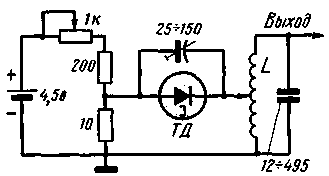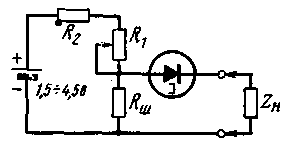The use of tunnel diodes. Encyclopedia of radio electronics and electrical engineering

Encyclopedia of radio electronics and electrical engineering / Radio amateur designer
 Comments on the article
Comments on the article
On fig. 1, 2 and 3 show three different circuit applications of the tunnel diode oscillator. The FM transmitter shown in Fig. 1 is very simple and provides reliable reception within a radius of 10-30 m when using a whip antenna and an FM receiver of medium sensitivity. Due to the fact that the transmitter modulation scheme is the simplest, the output signal is somewhat distorted, and, in addition to frequency modulation, obtained by changing the natural frequency of the generator synchronously with the microphone signal, there is significant amplitude modulation. It is impossible to greatly increase the output power of such a transmitter, since it is a source of interference. Such a transmitter can be used as a portable radio microphone, calling or intercom for short distances.

Rice. 1. The simplest tunnel diode transmitter.
Coil L contains 10 turns of PEL 0,2 wire.
The principle of operation of the local oscillator (Fig. 2) is the same as the previous transmitter. Its distinctive feature is the incomplete inclusion of the circuit. This is done in order to improve the shape and stability of the generated oscillations. An "ideal" sine wave can be obtained when in practice small non-linear distortions are unavoidable.

Rice. 2. Local oscillator on a tunnel diode L = 200 μH.
Shown in fig. 3 tuning fork generator can be used as a standard for tuning musical instruments or a telegraph buzzer. The generator can also operate on diodes with lower maximum currents. In this case, the number of turns in the coils must be increased, and the dynamic loudspeaker is turned on through an amplifier. For normal operation of the generator, the total ohmic resistance (r + r of the coil) must be less than ¦ - Rg ¦, and the position of the tuning fork legs relative to the magnetic core must be carefully adjusted.

Rice. 3. Audio frequency generator based on a tunnel diode
1 - tuning fork at a frequency of 440 Hz, 2 - magnetic core;
TD - gallium arsenide tunnel diode with current Imax=70mA; r = 9 ohm;
L1 \u2d L196 \uXNUMXd XNUMX μH - the inductance of the coil without a core;
K-key; GR-loudspeaker.
In order for the operating point of the diode to fall into the area with negative differential resistance, a voltage source with a very low internal resistance is required.
The value of this resistance in most cases ranges from several tens of ohms to several ohms. If the resistance connected in series with the tunnel diode turns out to be more than 2,5Rd, then the operating point cannot be stably located in the area with negative resistance.
To power devices on tunnel diodes, the circuit shown in Fig. 4 is used. The value of shunt resistance Rsh is selected from the condition Rsh=(0,2-0,3)Rd. Resistance R2 protects the diode and shunt Rsh from damage when the resistance R1 is fully removed.

Rice. 4 Tunnel diode DC bias scheme.
The power source can be accumulators or high capacity batteries. In this case, the selected operating point will be more stable over time.
Literature
- Radio No. 1, 1965
Publication: N. Bolshakov, rf.atnn.ru
 See other articles Section Radio amateur designer.
See other articles Section Radio amateur designer.
 Read and write useful comments on this article.
Read and write useful comments on this article.
<< Back
 Latest news of science and technology, new electronics:
Latest news of science and technology, new electronics:
A New Way to Control and Manipulate Optical Signals
05.05.2024
The modern world of science and technology is developing rapidly, and every day new methods and technologies appear that open up new prospects for us in various fields. One such innovation is the development by German scientists of a new way to control optical signals, which could lead to significant progress in the field of photonics. Recent research has allowed German scientists to create a tunable waveplate inside a fused silica waveguide. This method, based on the use of a liquid crystal layer, allows one to effectively change the polarization of light passing through a waveguide. This technological breakthrough opens up new prospects for the development of compact and efficient photonic devices capable of processing large volumes of data. The electro-optical control of polarization provided by the new method could provide the basis for a new class of integrated photonic devices. This opens up great opportunities for ... >>
Primium Seneca keyboard
05.05.2024
Keyboards are an integral part of our daily computer work. However, one of the main problems that users face is noise, especially in the case of premium models. But with the new Seneca keyboard from Norbauer & Co, that may change. Seneca is not just a keyboard, it is the result of five years of development work to create the ideal device. Every aspect of this keyboard, from acoustic properties to mechanical characteristics, has been carefully considered and balanced. One of the key features of Seneca is its silent stabilizers, which solve the noise problem common to many keyboards. In addition, the keyboard supports various key widths, making it convenient for any user. Although Seneca is not yet available for purchase, it is scheduled for release in late summer. Norbauer & Co's Seneca represents new standards in keyboard design. Her ... >>
The world's tallest astronomical observatory opened
04.05.2024
Exploring space and its mysteries is a task that attracts the attention of astronomers from all over the world. In the fresh air of the high mountains, far from city light pollution, the stars and planets reveal their secrets with greater clarity. A new page is opening in the history of astronomy with the opening of the world's highest astronomical observatory - the Atacama Observatory of the University of Tokyo. The Atacama Observatory, located at an altitude of 5640 meters above sea level, opens up new opportunities for astronomers in the study of space. This site has become the highest location for a ground-based telescope, providing researchers with a unique tool for studying infrared waves in the Universe. Although the high altitude location provides clearer skies and less interference from the atmosphere, building an observatory on a high mountain poses enormous difficulties and challenges. However, despite the difficulties, the new observatory opens up broad research prospects for astronomers. ... >>
 Random news from the Archive Random news from the Archive The first wooden satellite will be sent into space
15.06.2021
The world's first wooden satellite will be launched into space this year. The WISA Woodsat satellite measures approximately 10x10x10 cm and weighs approximately 1 kg. It is made of birch plywood with a special coating (WISA). The device is powered by nine small solar panels.
The wooden satellite will be launched as part of a mission developed by the Finnish company Arctic Astronautics, which makes cubesat kits for students. It will be launched into polar orbit by the Electron Rocket Lab rocket in November of this year. The purpose of the mission is to test the behavior and durability of plywood panels in extreme space conditions and evaluate their suitability for future missions.
The satellite will be equipped with two cameras, one of which will be attached to a metal selfie stick, allowing the mission team to observe how the surface of the satellite's plywood changes in the space environment.
"The base for plywood is birch, and we use basically the same stuff you find at a hardware store or for making furniture. Regular plywood is too wet to use in space, so we put our wood in a thermal vacuum chamber to dry it first. Then we apply molecular layering by adding a very thin layer of alumina, which is often used to encapsulate electronics," explained Woodsat chief engineer Samuli Nyman.
On June 12, the prototype satellite was launched into the stratosphere to a height of 31,2 km. The flight lasted 2 hours 54 minutes.
|
 Other interesting news:
Other interesting news:
▪ Display for creating 3D holograms in the air
▪ You can disrupt the operation of the HDD with the sound of ordinary speakers
▪ Hangover pills
▪ Stars that form gold are discovered
▪ Hyperloop analogue tested in China
 News feed of science and technology, new electronics
News feed of science and technology, new electronics
 Interesting materials of the Free Technical Library:
Interesting materials of the Free Technical Library:
▪ site section Lightning protection. Article selection
▪ article by Irvine Shaw. Famous aphorisms
▪ article Where and when was the person who committed the murder in front of witnesses fully acquitted? Detailed answer
▪ Wisnag's article. Legends, cultivation, methods of application
▪ See Parallel Phone Call. Encyclopedia of radio electronics and electrical engineering
▪ article Spinning coin. Focus Secret
 Leave your comment on this article:
Leave your comment on this article:
 All languages of this page
All languages of this page
Home page | Library | Articles | Website map | Site Reviews

www.diagram.com.ua
2000-2024







 Arabic
Arabic Bengali
Bengali Chinese
Chinese English
English French
French German
German Hebrew
Hebrew Hindi
Hindi Italian
Italian Japanese
Japanese Korean
Korean Malay
Malay Polish
Polish Portuguese
Portuguese Spanish
Spanish Turkish
Turkish Ukrainian
Ukrainian Vietnamese
Vietnamese




 Leave your comment on this article:
Leave your comment on this article: